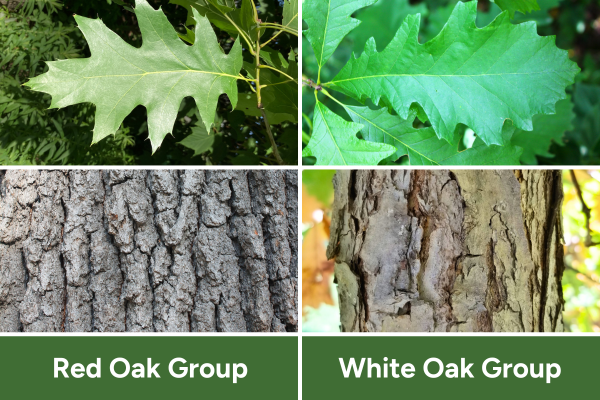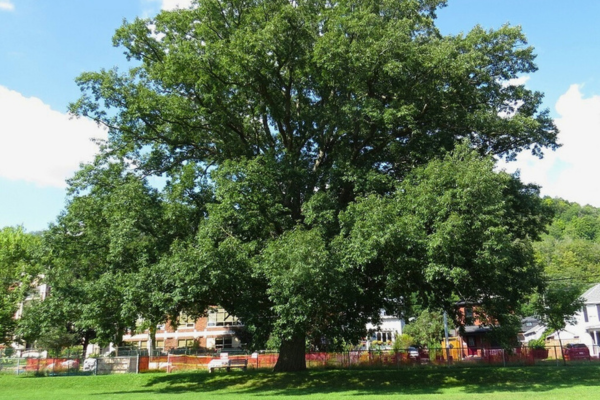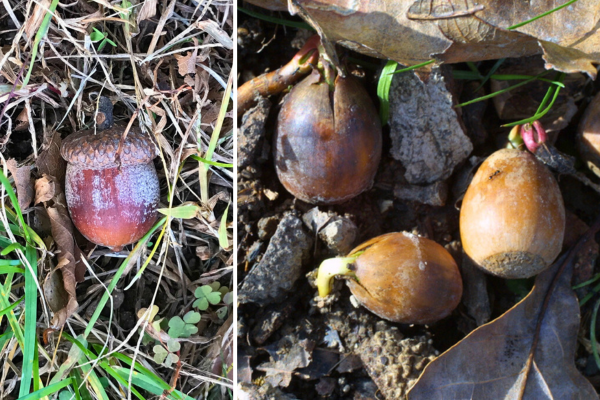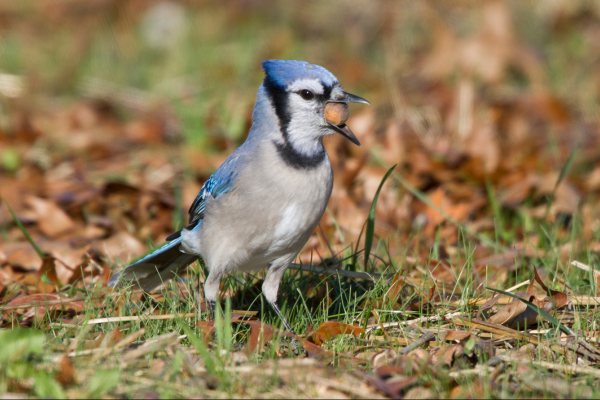In the plant world, “groups” are broad categories that bring together species with shared traits, helping us understand relationships and differences within a larger family. Among oaks, these groups are commonly divided into red oaks and white oaks, each with distinct characteristics that set them apart.
How to Tell Red Oaks from White Oaks
Leaf shape is one of the easiest giveaways. Red oaks have pointed lobes that end in little bristles, while white oaks have rounded lobes with no bristles at all. If you're standing under an oak tree and see leaves that look soft and curvy, it's probably a white oak.
Bark is another clue. Red oaks tend to have darker, ridged bark with vertical grooves. White oaks usually have lighter bark that looks more flaky or scaly.
The wood differs too. Red oak wood often has a reddish hue and an open grain pattern, which makes it less resistant to rot. White oak wood is light brown, sometimes with a hint of olive, and has a tighter grain that resists moisture — part of why it's often used for barrels and boats.

Who’s Who in Ontario?
You're likely to encounter a few key species in each group in Ontario. Common members of the red oak group include northern red oak (Quercus rubra), pin oak (Quercus palustris) and black oak (Quercus velutina). In the white oak group, you'll likely find white oak (Quercus alba), bur oak (Quercus macrocarpa), swamp white oak (Quercus bicolor) and chinkapin oak (Quercus muehlenbergii). Red and white oaks each bring something special to local ecosystems — and together, they make a powerful tag team.

What About Acorns?
Here’s where things get really interesting, because red and white oaks have very different strategies when it comes to producing acorns. Red oak acorns take two years to mature and are high in tannins, which makes them bitter. White oak acorns mature in just one year and have lower tannin levels, so they taste sweeter.
That bitterness isn’t just a quirky trait — it’s a survival strategy. The high tannin levels in red oak acorns act as both preservatives and deterrents. Because they’re less tasty, animals often pass them over in the fall when sweeter options, like white oak acorns, are available. This gives red oak acorns time to lie dormant through the winter. Rain and snow gradually leach out the tannins, making them more palatable by late winter — just when food is scarce. This strategy increases the chances that some acorns will be overlooked and survive the winter, ready to sprout in spring. Those that are found become food and those that are missed become trees.
White oak acorns, on the other hand, are a hot commodity. Animals like squirrels, deer, chipmunks, blue jays and wild turkeys snap them up as soon as they hit the ground. To beat the buffet line, white oak acorns germinate almost immediately in the fall, sending out a root before they can be carried away or eaten. This quick-start strategy gives seedlings a head start and helps ensure that at least a few make it through the feeding frenzy.

Both types of oaks also participate in what are called “mast years” — unpredictable cycles when trees produce an unusually large crop of acorns compared to typical years.
These years can overwhelm wildlife with food, increasing the odds that some acorns escape being eaten and go on to sprout. But even in mast years, red and white oaks stick to their own game plans: white oaks flood the forest with sweet acorns that germinate fast, while bitter red oak acorns wait for the long haul.

A Buffet in Two Acts
The different acorn strategies of red and white oaks affect more than just squirrel snack preferences. They provide a staggered food supply that benefits all kinds of wildlife. In the fall, animals feast on white oak acorns. As winter wears on and other food sources dwindle, red oak acorns become more appealing. This steady supply of food helps wildlife survive the harshest part of the year.
And that’s just one example of how tree diversity supports biodiversity. The more variety we have in our forests and backyards, the more resilient our ecosystems become.
So next time you spot an oak, take a closer look. Whether it’s red or white, it’s doing more than just looking majestic — it’s feeding the urban forest in its own time.
Interested in adding an oak tree to your yard? Whether it's a red oak or a white oak, these trees play a crucial role in supporting wildlife and enhancing #BackyardBiodiversity. Apply to the Backyard Tree Planting Program today and make a lasting impact on your local ecosystem.
Justin Lewis is the Marketing and Communications Lead at LEAF.
The #BackyardBiodiversity campaign is a partnership initiative with the Toronto Wildlife Centre.
LEAF offers a subsidized Backyard Tree Planting Program for private property. The program is supported by the City of Toronto, the Regional Municipality of York, the City of Markham, the Town of Newmarket, the City of Vaughan, the Regional Municipality of Durham, the Town of Ajax, the Municipality of Clarington, the City of Oshawa, the City of Pickering, the Township of Scugog and the Town of Whitby.
